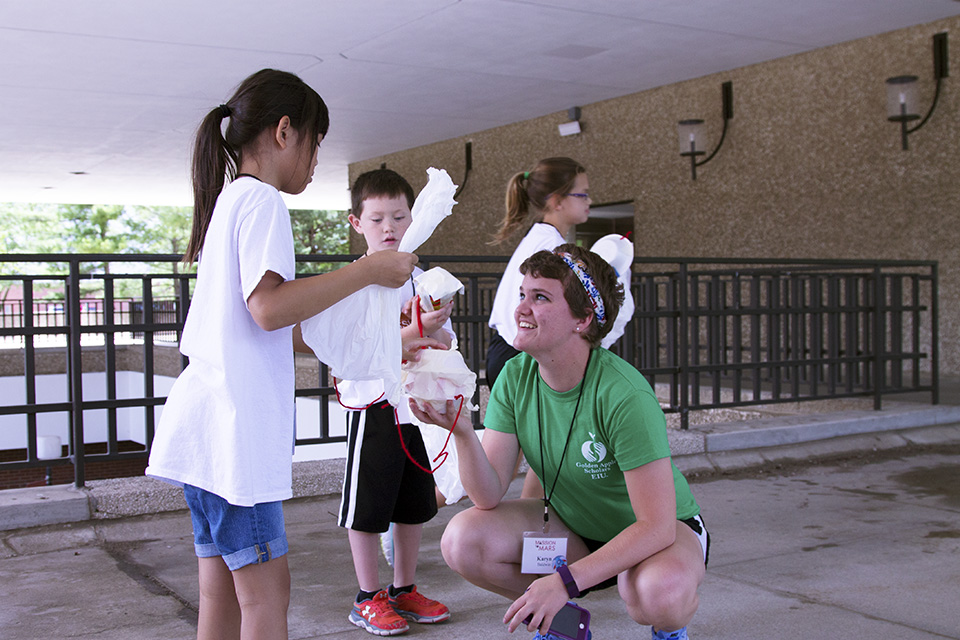After a week on the red planet, the young astronauts’ landing craft made its final descent, touching down next to DeGarmo Hall. With bated breath, the students tore away the escape hatch to reveal that their egg was still intact!
For 100 Bloomington-Normal kids ages 8–14, a balloon-and-parachute egg drop and rocket launch capped off a NASA-themed summer camp hosted on Illinois State’s campus in July. The experience, dubbed Mission to Mars, was created through a partnership with the Golden Apple Foundation.
The nonprofit’s scholar program provides intense support and scholarships to talented future teachers who are committed to serving high-needs schools for at least five years following graduation. Each summer the scholars engage with children in schools across the state. Mission to Mars transformed Metcalf School into a virtual space center and was taught by 22 of the scholars, including six Illinois State education students.
“The partnership was awesome,” said Golden Apple camp director and Redbird alumna Nancy Powell ’74, M.S. ’90. “We have had a great collaboration with Illinois State faculty and staff, and groups of three to four scholars were able to be in charge of their own classrooms, which is rare for these trainings.”
At the camp, the young astronauts engaged in STEAM (science, technology, engineering, art, and math) education. They simulated space travel, growing food on Mars, building a rover and exploring the planet’s surface, constructing a settlement, and returning safely to Earth.
“It was all hands-on activities. The teachers were all really nice, and I got to work on teams with people I otherwise would never have had the chance to meet,” said Natalie Malloy, an eighth grader at Chiddix Junior High School.
A strong partnership
Though this is the first time the Chicago-based foundation has set up a summer training at Illinois State, the connection between the two institutions is strong. Scholars can attend any of the state’s 52 educator preparation programs, but they overwhelmingly choose Illinois State. The University enrolls twice as many scholars as the next most popular institution, and 50 of the 200 new scholars for fall 2016 are Redbirds.
“I chose Illinois State because it is the best school for education in the state of Illinois, no matter what or who you want to teach,” said Nate Titus, a senior middle level education major and scholar who taught at the camp. “And since I’ve been here, so many school administrators have told us that there is an Illinois State pile and an ‘everyone else’ pile when it comes to hiring, and ISU candidates go on top. They know we’ve been well prepared.”
The scholars’ backgrounds reflect the diversity of the students they will serve in Illinois classrooms. Currently, less than half of Illinois’ P–12 population is white, yet white teachers account for more than 82 percent of the workforce, according to the Illinois State Board of Education.
“Golden Apple’s approach to take a certain percentage of diversity is a beautiful thing,” said Karyn Baldwin, a scholar and senior bilingual-bicultural elementary education major. “Though Nate and I are both white, we have shown that no matter who a student is, we can connect with them, and that’s a testament to our education at Golden Apple and ISU.”
Mission to Mars was the last Golden Apple summer training program for this group of scholars. It was also the first one the University has hosted with the Chicago-based foundation, but the camp’s success will likely lead to an annual partnership.
“The scholars knocked my socks off. Most of them did not have prior experience teaching math and science,” said Powell, a retired Bloomington High School math teacher and a Golden Apple Fellow, “but they put everything they had into this, and their confidence with STEM and STEAM activities grew tremendously.”
Ready for launch
Before the camp, scholars collaborated on the Mars curriculum with teachers in the Golden Apple network that literally put learning in students’ hands. From building rockets to creating Mars habitats, the young astronauts got the chance to show they had The Right Stuff.
“The teachers didn’t tell us, ‘The habitat has to be this shape,’” said Malloy. “They gave us a demonstration, some supplies, a few guidelines, and then let us be creative.”
Afterward, the campers were able to compare their designs to their teachers’ work.
“I really learned a lot about architecture, which I didn’t really expect to happen at a Mars camp,” said Alex Cox, an eighth grader at Bloomington Junior High School.
For Titus, a future social studies and language arts teacher, the learning was anything but one-sided.
“We taught the class, but the great part about the camp for me was that we learned from the students, too,” he said.
Baldwin said creativity was key to creating an environment where students felt like they were part of a real space program.
“We also brought it to life by taking concepts we know about earth—like water’s impact on land formations—and applying them to studying Mars,” said Baldwin. “For a while, they really do believe they’re there.”
Meeting the need
The strong demand for effective educators for high-need populations encompasses all of Illinois, not just Chicago. That’s something the scholars know well.
“Every student deserves an excellent education regardless of who they are or where they come from,” said Titus.
The ability of teachers to change the life of one student can have a far-reaching impact. It’s something Powell accomplished during 37 years of service, and Baldwin and Titus are committed to following her lead.
“High-need students have all the potential to change the world. Too often they do not get that chance because they have a label or a target on their back,” Baldwin said. “For all the benefits I’ve had, all I want to do is empower those students.”
Tommy Navickas can be reached at tjnavic@IllinoisState.edu.



